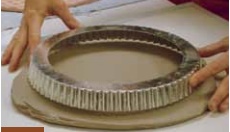
Everything But the Kitchen Sink

- School:
- Barron Collier High
- Subject:
- Art
- Teacher:
- Leslie Loughran
- Students Impacted:
- 200
- Grade:
- 9-12
- Date:
- September 1, 2017
Investor
Thank you to the following investor for funding this grant.
Suncoast Credit Union - $202.00
Original Grant Overview
Goal
One of the highest level thinking skills that can be used when teaching children is to ask them to transform or alter a project in form, function, or through a process. In ceramics, I am constantly asking my students to ‘think outside the box’, ‘create something unique’, or ‘experiment with’ a process. Recently, I found a ceramics lesson that utilized fruit tart pans for creating a set of unique nesting bowls...which led me to wonder, what other kitchen tools could be utilized to transform ceramic processes? As it turns out, quite a few.
The goal of this unit is to provide the students with a variety of kitchen tools and ask them to either use them in ways that will transform either a traditional clay process or clay product. I am asking the students to use their upper level thinking skills and their problem solving skills to take a traditional process and an unrelated tool, and put them together to create a new result.
What will be done with my students
First, students will be taught three different hand-building techniques using traditional clay tools: pinching, coil building, and slab building. Students will complete a variety of projects from simple (Ceramics 1 students) to complex (Ceramics 3 Honors and AP students) using these traditional methods and tools. Once students have mastered these techniques and tools, they will be presented with an array of kitchen tools…not normally used in the ceramic process and given this challenge: Use at least two of these tools and your experience with hand-building techniques to either develop a new ceramics technique or to create a new ceramic project. If you develop a technique, you must demonstrate and teach it to the class. If you create a new type of project, you must complete it, fire and glaze it, and present it to the class with an explanation of how it is the result of a trans-formative project. Student techniques and projects will be scored using a scale and rubric that relates back to the two visual art standards explained below in the ‘benefit’ section of this grant. Final projects will be displayed in our spring show at the Headquarters Public Library.
Benefits to my students
Two of the visual art standards established by the state of Florida ask the students to ‘use divergent thinking, abstract reasoning, and various processes to demonstrate imaginative or innovative solutions for art problems’ and to ‘manipulate or synthesize established techniques as a foundation for individual style initiatives in two-, three-, and/or four-dimensional applications’. Providing the students with a direct challenge to transform or altar a known product or process and providing them with unusual (to the process of clay) tools will place them directly in the path of having to use divergent thinking and to manipulate known techniques. In completing this challenge, students will be successful when they have developed a new technique or created a unique project. By setting this project up in a relatively structured way, where the students will be forced to transform or alter or adapt to the situation, I am hoping to begin to develop a habit of the mind where students will look at other situations and think about how they can transform the usual into the unusual.
Budget Narrative
All items except for the pastry bags are non-consumable and may be used again in future years.
Items
| # | Item | Cost |
|---|---|---|
| 1 | Set of 3-assorted size tartlet pans | $21.00 |
| 2 | 4-pastry wheels | $26.00 |
| 3 | 12-piece ruffled round cookie cutter set | $17.00 |
| 4 | 12-piece round cookie cutter set | $11.00 |
| 5 | 6-4 inch tartlet pans | $12.50 |
| 6 | rectangular ridged tart pan | $10.50 |
| 7 | set of 4 heart tart pans | $9.50 |
| 8 | 21" long bread tray | $24.00 |
| 9 | rectangular bread tray | $36.00 |
| 10 | 50 extra thick piping bags | $6.50 |
| 11 | set of 4 nylon pan scrapers | $7.00 |
| 12 | dumpling maker | $5.00 |
| 13 | 2 garlic presses | $16.00 |
| Total: | $202.00 |



Share
Please share this page to help in fulfilling this grant.
Email to a Friend